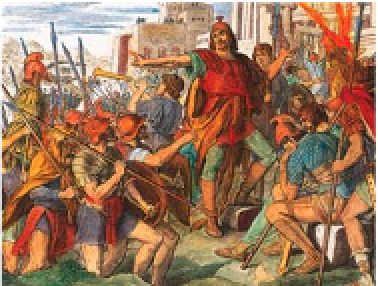Travel Reference
In-Depth Information
going to the Syria-based Seleucids. The
culture of the Greeks spread through-
out the region. This era saw the rise of
the Decapolis (“ten cities” in Greek), a
loose grouping of Hellenistic city-states
in an otherwise Semitic land-
scape, which included
Philadelphia (
BABYLONIAN CAPTIVITY
According to the Bible, after Solomon
died, conflicts led to the division of the
Jewish nation into two separate parts:
the Kingdom of Israel in the north and
the Kingdom of Judaea in the south.
Two centuries later,
the Assyrians con-
quered the north, and
many of the Jews of
Israel were deported.
When Judaea withheld
tribute, it too was
invaded and defeated
at the battle of Lachish.
The Assyrians, in turn,
were defeated by the
Babylonians who, in 587 BC, captured
Jerusalem and destroyed Solomon's
Temple, forcing the Jews of Judaea
into exile. During the brief period of
Babylonian captivity the Jews main-
tained and even strengthened their
cultural and religious identity.
Defeated by the Persians under Cyrus
the Great in 538 BC, the Babylonians
disappeared from history and the Jews
were allowed to return to their land.
( mman),
( erash) and Scy-
thopolis (Beth Shean).
But Jerusalem resisted.
The response of the
Seleucid king Antiochus
IV Epiphanes (175-164
BC) was to rededicate
the Jews' temple in
Jerusalem to Zeus and
make observance of Hebrew law pun-
ishable by death. Led by Judas
Maccabeus, a priest of the Hasmonean
family, the Jews rebelled in 164 BC.
They defeated the Seleucids, took
complete control of Jerusalem and
reconsecrated their Temple.
Rule of Judaea was assumed by the
Hasmoneans. However, independence
for the Jews did not ensure peace.
There was bitter conflict between the
Hasmoneans and the Pharisees, a rival
priestly sect who propounded strict
observance of Hebrew religious tra-
dition. In the struggle for influence,
Gerasa (
Israelite prisoners leaving Lachish after its
fall to the Assyrians in 701 BC
THE SECOND TEMPLE
Returning to Jerusalem, in the 6th cen-
tury BC, the Jews built a new temple
on the same site as the first. This event
in the history of Jerusalem marks the
beginning of what is referred to as the
“Second Temple” period.
The Persians remained dominant in
the region until their empire was torn
apart by the armies of Alexander the
Great. Judaea was swallowed up in the
wake of the Macedonian's triumphant
progress into Egypt. On the death of
Alexander, his empire was split
between three generals; the dynasties
they founded proceeded to fight over
the spoils, with Palestine eventually
The recapture of the Temple by Judas Maccabeus in
his successful revolt against the Seleucids, 164 BC
TIMELINE
722 BC
Assyria
conquers the Kingdom
of Israel and sends the
Israelites into exile
587 BC
The Babylonians
conquer Jerusalem and
destroy the First Temple
515 BC
The
founding of the
Second Temple
Alexander the Great,
whose successors
Hellenized Palestine
800 BC
700 BC
600 BC
500 BC
400 BC
538 BC
Cyrus
the Great frees
the Jews in exile
in Babylon
The seal of Jeroboam,
a 9th-century Jewish
king
332 BC
Alexander the
Great conquers
Palestine








































